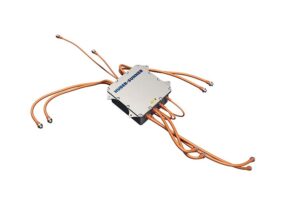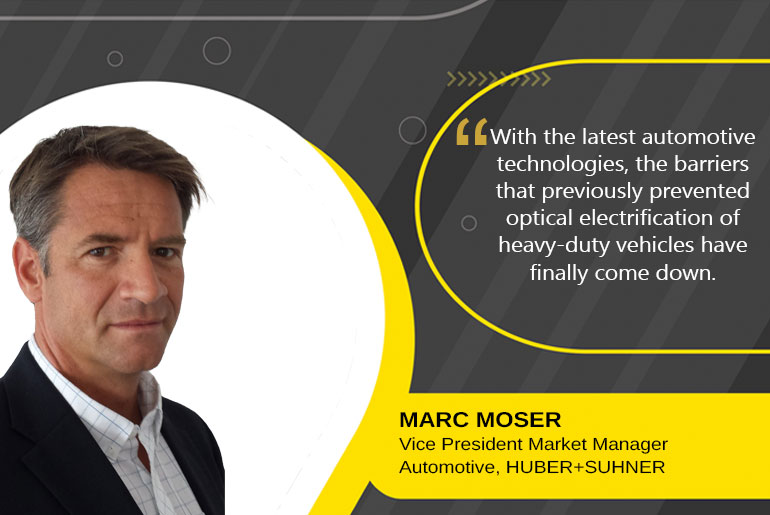The demand for electric vehicles has become insatiable, with sales growing by more than 90% in both the United States and Europe, and by more than 300% in China between 2020-2022. As a result, both the personal and commercial vehicle markets are seeing increased interest in electric powertrain components, which are used to generate and deliver power throughout the vehicle for electric applications.
 As governments continue to roll out stringent carbon neutrality directives, electric vehicle powertrains offer cleaner emissions through decarbonization and greater fuel economy. This has made them an attractive choice for light and medium duty vehicles, such as passenger cars and vans. For heavy-duty vehicles such as buses and trucks, powertrain electrification has proven more of a challenge: Commonly used in high-intensity applications, and often in harsh conditions, these vehicles have proven more susceptible to fatigue and failures. As innovative new technologies come to market, however, these challenges may soon become concerns of the past.
As governments continue to roll out stringent carbon neutrality directives, electric vehicle powertrains offer cleaner emissions through decarbonization and greater fuel economy. This has made them an attractive choice for light and medium duty vehicles, such as passenger cars and vans. For heavy-duty vehicles such as buses and trucks, powertrain electrification has proven more of a challenge: Commonly used in high-intensity applications, and often in harsh conditions, these vehicles have proven more susceptible to fatigue and failures. As innovative new technologies come to market, however, these challenges may soon become concerns of the past.
Challenge 1: Lengthy manufacturing processes
One of the first issues when it comes to ensuring reliable electrification comes during the manufacturing process. In order to have an uninterrupted power supply and keep high-voltage connection systems in place, it is important that the layout and all fixation points within the vehicle are also optimally selected for each unique requirement. These systems are vital in establishing reliable connections to powertrain components and connectors, but this can only be achieved so long as the cables between them are laid in an effective manner.
Typically, the large cross-section cables used in heavy-duty vehicles are long, heavy, and often very stiff. This rigidity is often due to the fact that many cable solutions require additional covering for protection tubes, increasing the potential bend radius. Ensuring these high-voltage cables are laid correctly in each corner of a vehicle is time-consuming and generates extended installation times for manufacturers. Demands for electric vehicles are ever increasing, and if these are to be met, solutions that can reduce time-to-market are essential.
Challenge 2: Withstanding harsh conditions
Once out on the road, another potential issue for businesses is ensuring the resilience needed to protect powertrain components. As heavy-duty electric vehicles run on such high voltages, their operating systems are highly susceptible to deterioration. When combined with the harsh conditions these vehicles experience during long distance, year-round traversing, the likelihood of failure increases. Frequent exposure to mechanical abrasion, severe weather conditions, moisture and fluctuating temperatures can lead to significant damage and malfunctioning systems.
These issues negatively affect a company’s organisational efficiency – disruptions in travel cause delays and erode customer satisfaction. Repairs may also prove a costly venture, so manufacturers need to ensure robust infrastructure is in place from the outset to mitigate potential damage and ensure the powertrain components maintain optimal performance.
Challenge 3: Ensuring longevity of components
Natural elements may be unavoidable, but vulnerabilities within power distribution elements can also impact performance. In heavy-duty applications such as loading, these solutions come under significant pressure. Any propagation of cracks within essential materials will only worsen during each loading cycle until a full fracture takes place. This happens more often in heavy-duty vehicles than other vehicle types owing to the nature of the work they are used for, and that is a key reason why electrification has proven a challenge in the past.
Meeting market demands
 Thankfully, businesses can now rely on new solutions that have undergone significant testing and validation processes to conquer these challenges. To best support businesses during the manufacturing process, automotive innovations such as the RADOX® EV-C connection system from HUBER+SUHNER offer greater freedom and flexibility when routing and organising high-voltage cables. Solutions like EV-C incorporate proven technologies like RADOX® and its innovative electronic beam crosslinking process to optimise high-voltage cables. These cables provide greater malleability and customisability than traditional cable options, speeding up the installation time while reducing inefficiencies and the need for reworks. These specialised cable glands mean manufacturers and their suppliers no longer have to source and assemble individual cables, connectors, and high-voltage distribution units from separate suppliers, as they come in a single end-to-end solution. This leads to a reduced time-to-market, which is necessary to meet the rising demand for electric vehicles.
Thankfully, businesses can now rely on new solutions that have undergone significant testing and validation processes to conquer these challenges. To best support businesses during the manufacturing process, automotive innovations such as the RADOX® EV-C connection system from HUBER+SUHNER offer greater freedom and flexibility when routing and organising high-voltage cables. Solutions like EV-C incorporate proven technologies like RADOX® and its innovative electronic beam crosslinking process to optimise high-voltage cables. These cables provide greater malleability and customisability than traditional cable options, speeding up the installation time while reducing inefficiencies and the need for reworks. These specialised cable glands mean manufacturers and their suppliers no longer have to source and assemble individual cables, connectors, and high-voltage distribution units from separate suppliers, as they come in a single end-to-end solution. This leads to a reduced time-to-market, which is necessary to meet the rising demand for electric vehicles.
When out on the road, greater reliability can now be achieved through solutions like a modular High-Voltage Distribution Unit (mHVDU). Contributing to an increased lifespan of heavy-duty electric vehicles, mHVDUs have built-in Electromagnetic Compatibility (EMC) and Internal Protection (IP) features to secure the power distribution system and cables when a vehicle is in use. These features can help mitigate any potential damage caused by harsh conditions and elements such as dirt, dust, or moisture. At the same time, the protection offered through mHVDUs can reduce the impact of intensive tasks, resulting in less fatigued components.
As mHVDUs are typically made from lightweight aluminium, manufacturers can benefit from compact installation and enhanced space and weight savings, while the internal components enhance the vehicle’s voltage capacity. Effective conduction of electric power can then be achieved, held, and distributed after charging to ensure the best possible electrical performance.
Accelerating innovation
With the latest automotive technologies, the barriers that previously prevented optical electrification of heavy-duty vehicles have finally come down. Modern connectivity solutions ensure greater protection against the elements, with innovative systems designed to meet the latest automotive standards and reliably deliver electrical connections. The benefits of products like EV-C and mHVDU are clearcut: for manufacturers, they can simplify the installation of electric vehicles and reduce time-to-market. For operators, they can rest assured the vehicle is less susceptible to harsh conditions and wear and tear, even when in constant use.
Looking to the future, the ongoing dynamic development of electromobility has resulted in new directions of research within the automotive sector. One of these has been greater analysis of vibrations within electric vehicles, and the effect this has on performance and degradation. Vulnerabilities found in previous high-voltage connection systems were heightened as a result of shocks and vibrations, often leading to fatigue failure and shorter vehicle lifespans. Current solutions now offer greater protection against this issue, but vendors are now working on enhanced systems which offer increased vibration performance. This will be music to the ears of heavy-duty vehicle operators, enabling them to keep their assets on the roads without the fear of critical failures.

